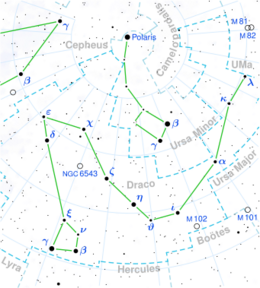Astronomy:Phi Draconis
| Observation data Equinox J2000.0]] (ICRS) | |
|---|---|
| Constellation | Draco |
| Right ascension | 18h 20m 45.43224s[1] |
| Declination | 71° 20′ 16.1499″[1] |
| Apparent magnitude (V) | 4.22[2] |
| Characteristics | |
| Spectral type | B8VpSi[3] + A4V + B9V[4] |
| U−B color index | −0.38[5] |
| B−V color index | −0.10[5] |
| Variable type | α2 CVn[2] |
| Astrometry | |
| Radial velocity (Rv) | −16.44[6] km/s |
| Proper motion (μ) | RA: −5.03[1] mas/yr Dec.: +37.86[1] mas/yr |
| Parallax (π) | 10.77 ± 0.38[1] mas |
| Distance | 300 ± 10 ly (93 ± 3 pc) |
| Absolute magnitude (MV) | −0.74 (−0.48/+0.94)[4] |
| Orbit[4] | |
| Primary | A |
| Companion | B |
| Period (P) | 307.8 yr |
| Semi-major axis (a) | 0.965" (89.60 au) |
| Eccentricity (e) | 0.752 |
| Inclination (i) | 95.6° |
| Orbit[6] | |
| Primary | Aa |
| Companion | Ab |
| Period (P) | 127.914 d |
| Eccentricity (e) | 0.6725 |
| Inclination (i) | 48° |
| Semi-amplitude (K1) (primary) | 33.87 km/s |
| Details | |
| Aa | |
| Mass | 3.3[4] M☉ |
| Radius | 2.7±0.2[7] R☉ |
| Luminosity | 107[7] L☉ |
| Surface gravity (log g) | 4.21±0.08[7] cgs |
| Temperature | 11,429[7] K |
| Rotation | 1.7165[6] |
| Rotational velocity (v sin i) | 81.5[6] km/s |
| Age | 245[4] Myr |
| Ab | |
| Mass | 1.36[8] M☉ |
| B | |
| Mass | 2.25[8] M☉ |
| Age | 330[4] Myr |
| Other designations | |
| Database references | |
| SIMBAD | data |
Phi Draconis (φ Dra / φ Draconis) is a fourth-magnitude variable star in the constellation Draco. It has the Flamsteed designation 43 Draconis. It is also a triple star system where the brightest component is a chemically peculiar Ap star.

The brightness of φ Draconis varies by about 0.04 of a magnitude every 1.7 days. This is due to very strong magnetic fields at the surface of the star, and it is classified as an α2 Canum Venaticorum variable.[2]
φ Draconis is a multiple star system containing three stars. The inner pair form a single-lined spectroscopic binary in an eccentric 128-day orbit. The outermost star orbits the inner pair every 308 years. The outer pair can be resolved visually and have a semi-major axis of 0.752″. A fourth component, C, is also listed in multiple star catalogues, but is only a chance alignment with the triple system.[4]
Phi Draconis Aa is a main-sequence Ap star with a spectral class of B8. The main abundance excess is silicon, although iron and chromium and also notably elevated.[10]
In Chinese astronomy, φ Draconis is called 柱史 (Pinyin: Zhùshǐ), meaning Official of Royal Archives, because this star is marking itself and stand alone in Official of Royal Archives asterism, Purple Forbidden enclosure (see: Chinese constellations).[11]
References
- ↑ 1.0 1.1 1.2 1.3 1.4 van Leeuwen, F. (November 2007). "Hipparcos, the New Reduction" (VizieR). Astronomy and Astrophysics 474 (2): 653–664. doi:10.1051/0004-6361:20078357. Bibcode: 2007A&A...474..653V. http://vizier.u-strasbg.fr/viz-bin/VizieR-S?HIP%2089908. Retrieved 2010-11-22.
- ↑ 2.0 2.1 2.2 Samus, N. N. et al. (2009). "VizieR Online Data Catalog: General Catalogue of Variable Stars (Samus+ 2007-2013)". VizieR On-line Data Catalog: B/GCVS. Originally Published in: 2009yCat....102025S 1. Bibcode: 2009yCat....102025S.
- ↑ Gray, R. O.; Corbally, C. J. (2014). "An Expert Computer Program for Classifying Stars on the MK Spectral Classification System". The Astronomical Journal 147 (4): 80. doi:10.1088/0004-6256/147/4/80. Bibcode: 2014AJ....147...80G.
- ↑ 4.0 4.1 4.2 4.3 4.4 4.5 4.6 Liška, J. (2016). "Analysis of the multiple system with chemically peculiar component φ Draconis". Monthly Notices of the Royal Astronomical Society 461 (1): 939–947. doi:10.1093/mnras/stw1355. Bibcode: 2016MNRAS.461..939L.
- ↑ 5.0 5.1 Mermilliod, J.-C. (1986). "Compilation of Eggen's UBV data, transformed to UBV (unpublished)". Catalogue of Eggen's UBV Data: 0. Bibcode: 1986EgUBV........0M.
- ↑ 6.0 6.1 6.2 6.3 Kochukhov, O.; Papakonstantinou, N.; Neiner, C. (2022). "Magnetic field topology, chemical spot distributions, and photometric variability of the Ap star φ Draconis". Monthly Notices of the Royal Astronomical Society 510 (4): 5821. doi:10.1093/mnras/stac066. Bibcode: 2022MNRAS.510.5821K.
- ↑ 7.0 7.1 7.2 7.3 North, P. (June 1998). "Do SI stars undergo any rotational braking?". Astronomy and Astrophysics 334: 181–187. Bibcode: 1998A&A...334..181N.
- ↑ 8.0 8.1 Tokovinin, Andrei (2018-03-01). "The Updated Multiple Star Catalog". The Astrophysical Journal Supplement Series 235 (1): 6. doi:10.3847/1538-4365/aaa1a5. ISSN 0067-0049. Bibcode: 2018ApJS..235....6T.
- ↑ "MAST: Barbara A. Mikulski Archive for Space Telescopes". Space Telescope Science Institute. https://mast.stsci.edu/portal/Mashup/Clients/Mast/Portal.html.
- ↑ Prvák, M.; Liška, J.; Krtička, J.; Mikulášek, Z.; Lüftinger, T. (2015). "Modelling of variability of the chemically peculiar star ϕ Draconis". Astronomy and Astrophysics 584: A17. doi:10.1051/0004-6361/201526647. Bibcode: 2015A&A...584A..17P.
- ↑ (in Chinese) AEEA (Activities of Exhibition and Education in Astronomy) 天文教育資訊網 2006 年 6 月 10 日
External links
- Jim Kaler's Stars, University of Illinois: PHI DRA (Phi Draconis)
- An Atlas of the Universe: Multiple Star Orbits
Coordinates: ![]() 18h 20m 45.43s, +71° 20′ 16.13″
18h 20m 45.43s, +71° 20′ 16.13″
 |


